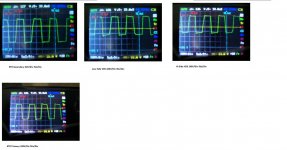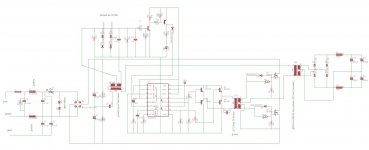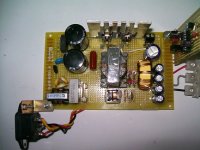Hi Microsim here is the latest schematic
View attachment 1318 and circuit layout
View attachment 1317. What did make the SMPS work was the change in layout by moving the oscillator far outside on a card, bringin the core closer to the Mosfets and properly laying out the connections i had some wires crossing below the board. They were insulated but most probably causing the mosfets to cross conduct by inducing false turn on. there is also one other thing that i changed, i made the connections with those output wires coming from pc smps they behave very strangely when used tinned with solder and connected to high frequency ac signals they seem to be good for dc only.
I made the new connections using basic copper wire and it worked great.
One other thing is that all the cores used here are recycled from PC PSU i.e. main core and current sense tranfo. The GDT core came from a CFL lamps a 100W philips white light model i think. If i did not purchase and inductance meter i would have never been able to find out the AL of these core and use the proper one.
The core AL are as follows: Main core 3885 GDT is around 6000 or 9000 i think i mentionned it somewhere in this post.
Bad news i don't have a 500W load handy i need to build or assemble one. Do you have any suggestion? 10W resistors on heatsink?+fan or metal resistors on heatsink+fan? Or is there any other way? I read about oil cooled resistors but it seems annoying and dangerous
Diyaudio is becoming more and more worse as days go by. I don't understand how some people there tell me that things are incorrect in my design and I never saw them post any projects and they give you book citations and formulae. Many times i have seen some people telling me what i did in my amp design/setup was bad and when you look at their project they did worse and everybody applause and copy their designs. If it weren't to do things by myself i would never been able to achieve this:
http://www.diysmps.com/forums/showt...red-loudspeaker-inspired-from-studio-monitors and am glad i did it without their help
 . The rise and fall times aren't time accurate but the top and botom of the wave are. This was taken with SMPS isolated and fed with 212Vac and 200W bulbs in series and 100W bulbs on each output no core heating no mosfet heating
. The rise and fall times aren't time accurate but the top and botom of the wave are. This was taken with SMPS isolated and fed with 212Vac and 200W bulbs in series and 100W bulbs on each output no core heating no mosfet heating . The rise and fall times aren't time accurate but the top and botom of the wave are. This was taken with SMPS isolated and fed with 212Vac and 200W bulbs in series and 100W bulbs on each output no core heating no mosfet heating
. The rise and fall times aren't time accurate but the top and botom of the wave are. This was taken with SMPS isolated and fed with 212Vac and 200W bulbs in series and 100W bulbs on each output no core heating no mosfet heating

